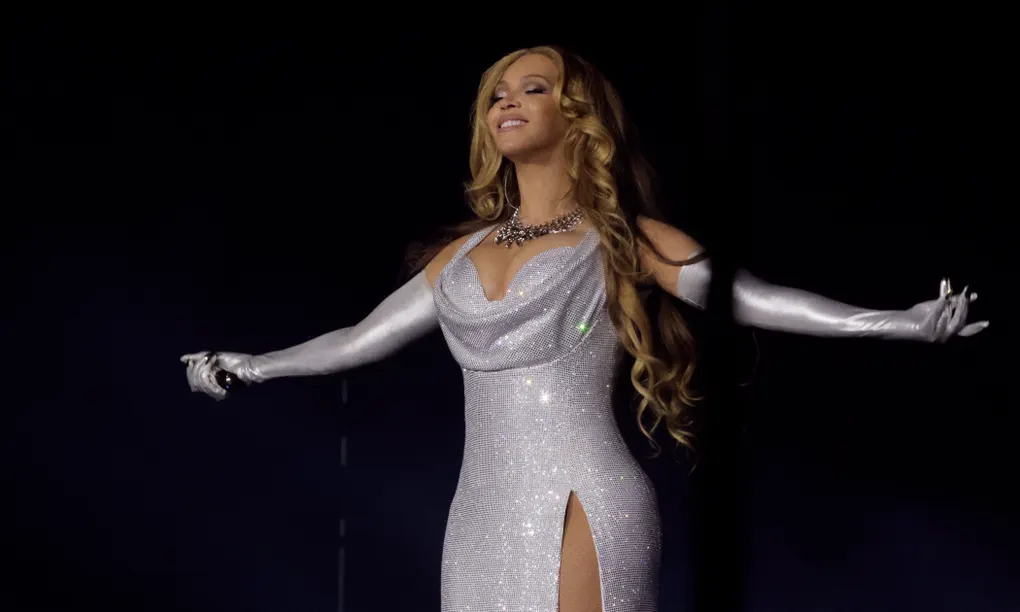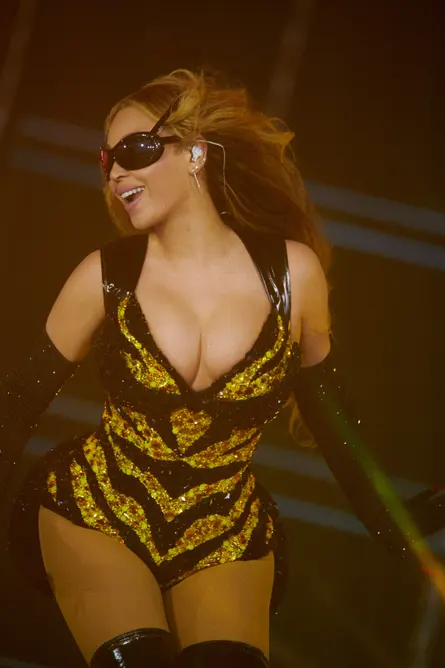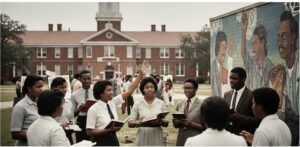Beyoncé review – a spangled supernova of joy

By: Kitty Empire
The megastar’s 2022 album, Renaissance, celebrated Black beats and queer culture, and its live show turns that tribute into next-level liberation for all
It begins with what looks like an old-fashioned TV test card but is in fact the colors of the Progress Pride flag, arrayed across the back of the giant stage. It ends with a photo of Beyoncé’s mother and her “godmother” – her late Uncle Jonny, to whom Renaissance, Beyoncé’s seventh album, is dedicated; a gay man who was HIV-positive. In between is a two-and-a-half-hour assault on the senses, in which the word “shiny” ceases to have meaning. Somehow, Beyoncé has taken a mirrorball and multiplied it by tinsel, then lacquered it in liquid titanium and thrown a post-marathon aluminum foil blanket on it for good measure. The result is a set of outfits – and a wider spectacle – so dangerously gleaming that the many thousand people in this Cardiff stadium really should be watching the third night of the Renaissance world tour through a pinhole projector, as one might view an eclipse. Beyoncé herself occasionally sports shades.
Roughly a year on from its release, Renaissance has been conspicuous by its relative absence. No videos have been forthcoming. Tonight more than makes up for that. Maximalist is expected in stadiums, and especially from stars like Beyoncé, 20 years into a solo career that has only become more opulent, more emotionally gripping and more overtly political as it has gone on. But this banging, progressive, LGBTQ+-embracing, Afrofuturist extravaganza is a masterclass in refined excess.
‘This song means more and more to me as I mature,’ Beyoncé notes of Flaws and All, a track from 2006

The props are next-level, combining nods to disco history (Bianca Jagger on horseback at Studio 54) with the idea that Beyoncé is an “alien superstar” – or at least, one from a more advanced civilization where prejudice of all kinds has been eradicated and everything is exquisite. If the whole thing is retina-melting, the maths are eye-watering. The Cardiff show has been days in the setting up; the vast band, the corps of dancers, the backing vocalists, horn section and crew constitute a small city. Forbes magazine has calculated that this world tour could net Beyoncé about $2.4bn.
These moving parts are also often hilarious. Beyoncé sits astride a tilting moon rover for a section that ends with her remix of Megan Thee Stallion’s Savage. As a nod to her nickname, Beyoncé dresses up as a bee for America Has a Problem. At the peak pose of a show with multiple climaxes, she flies around on a blindingly bejewelled horse – known to fans as Reneigh, trailed earlier as a giant statue. A cyborg version of Beyoncé is a recurring image, which references Fritz Lang’s Metropolis and the concept of being reborn. A nod to Botticelli’s The Birth of Venus continues the theme when Beyoncé sings from inside a giant silver clamshell.
Equally startlingly, she doesn’t play that many of her old hits, focusing on the hard-edged club feel of Renaissance and working in an array of songs from her catalogue. A short pre-Renaissance prelude reminds us of the soul-tinged R&B star of old. “This song means more and more to me as I mature,” Beyoncé notes of Flaws and All, a track from 2006.
If a kind of Stendhal syndrome-level overwhelm feels like a distinct possibility, one overarching narrative informs much of the action. On both album and tour, Beyoncé pays tribute to Black dance music genres: Chicago house and Detroit techno, ballroom and bounce. The automotive history of Detroit is hinted at by the recurring presence of factory-style robot arms which “assemble” her and eventually take on a dancing life of their own. Umpteen references to queer club culture abound, the funniest of which stars Beyoncé as a news anchor on “KNTY News” (“cunty” meaning fierce; a track of the same name by ballroom artist Kevin Aviance is interpolated elsewhere). What seems a lifetime ago, a sweeter, more conventional iteration of Beyoncé dedicated an album to her then more outre alter ego, Sasha Fierce. Beyoncé really did once resemble a “church girl acting loose”, as per Church Girl, the Renaissance song. That braver Beyoncé is now armoured and rocket-powered.
One section encapsulates the emancipatory next-levelness: a pugnacious workout in which a trio of Renaissance club tracks are delivered in even sweatier forms. The Queens remix of Break My Soul interpolates sections of Madonna’s Vogue, acknowledging a previous time a major US pop star paid tribute to the innovations of dance music’s queer crucibles. Enveloped within are further nods to fellow musicians: Lizzo, Tierra Whack and Santigold are just three contempories named. Sister Rosetta Tharpe, Bessie Smith and “Helen Folasade Adu”, AKA Sade, are pioneers recognised.
In among all this bass and bling, Beyoncé’s voice remains commanding. But her more conventional soul melismas are rationed tonight, with staccato raps, ecstatic noises and edicts to the fore. If Lemonade, Beyoncé’s previous record, was a nuanced statement of Black pride, Renaissance revels in unbridled physical liberation for “everybody”. There are women in the band. There are plus-sized dancers, although there could be more. A giant silver duvet envelops Beyoncé at the end of Cozy, a song about being comfortable in your own skin. Whether overtly intended or not, a woman on horseback doesn’t just tilt at Studio 54, it suggests the notion of a warrior queen, of a Boudicca – an image that contrasts with the more prevalent colonial narratives: statues of chaps on horseback.








